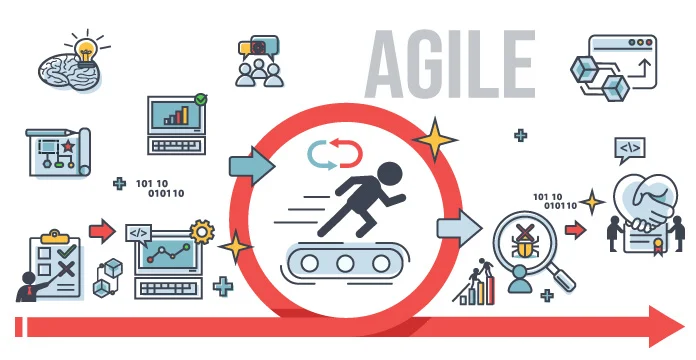Agile development has revolutionized the software industry, bringing flexibility, speed, and customer-centricity to the forefront.
In this dynamic landscape, effective release planning and road mapping play a pivotal role in delivering value and achieving business objectives.
At the heart of this process is the Agile product owner, a key figure responsible for guiding the development journey.
In this article, we’ll delve into the multifaceted role of the Agile product owner in release planning and road mapping.

Understanding the Agile Product Owner Role
In the realm of Agile teams, the product owner wears many hats. Their role extends beyond a mere project manager; they are the custodian of the product vision. As the bridge between stakeholders and development teams, the product owner is tasked with deciphering intricate customer and stakeholder needs.
This is more than a checklist exercise; it’s about crafting a product that resonates with users, addressing their pain points, and meeting their desires.
The Significance of Release Planning and Roadmapping
Release planning isn’t just a box to check; it’s a strategic endeavor that aligns development with business strategy. The roadmap, akin to a treasure map, charts the course of the product’s evolution.
A well-crafted product roadmap ensures that the development journey remains on course, even as the landscape shifts. It isn’t a crystal ball, but it can predict and mitigate potential obstacles, making it an indispensable tool.
Key Components of Release Planning
Release planning is akin to composing a masterpiece – it requires precision, creativity, and a deep understanding of the audience.
Let’s dive into the key components that harmonize to create a successful release plan:

Product Vision
Imagine standing on the conductor’s podium, holding the baton of the product vision. This vision serves as the North Star, guiding every decision and note throughout the journey. A well-defined product vision crystallizes the purpose, sets the tone, and ensures that every note contributes to the symphony’s grandeur.
Agile Product Roadmap
Picture a musical score – a roadmap that outlines the melody and rhythm of the entire composition. The Agile product roadmap is a dynamic canvas, outlining the sequence of releases, milestones, and overarching goals. It’s a visual representation of how the music unfolds, allowing everyone to sync their steps and keep in tune with the evolving melody.
User Stories
In this symphony, user stories are harmonious narratives that capture the essence of what users truly desire. Each user story is a musical phrase, a snapshot of a feature’s purpose and value. These stories ensure that every element of the composition aligns with the listeners’ expectations, ensuring that the final performance resonates deeply.
Agile Teams
Imagine an orchestra – a synergy of different instruments creating a harmonious blend. Similarly, Agile teams are an ensemble of diverse talents, each contributing their unique expertise to the composition. The product owner leads this orchestra, ensuring that each section plays in harmony, creating a cohesive and delightful experience.
Release planning isn’t a solo act; it’s a symphony of collaborative efforts. The conductor, in this case, the product owner, guides these components to create a harmonious and resonant release plan that captivates the audience – the customers and stakeholders. Just as a symphony comes together note by note, the release plan is meticulously crafted, with each component contributing to the final masterpiece.
Stay tuned as we move from composing the symphony to orchestrating its performance in the Agile Release Planning Process.
The Agile Release Planning Process
Imagine stepping into the grand hall of possibilities, where the orchestration of a well-structured release plan comes to life. The agile release planning journey is where the harmonious integration of strategy, creativity, and execution takes center stage. Let’s uncover the intricate steps that transform ideas into a crescendo of innovation:

Gathering Customer Feedback and User Insights
Every great composition considers its audience. Likewise, the agile release planning journey begins with immersing oneself in the audience’s desires and expectations. This entails collecting customer feedback and user insights and tuning into their preferences, pain points, and aspirations. By capturing these melodic nuances, the product owner ensures the symphony resonates deeply with the listeners.
Prioritizing Features and Functionalities
Picture a composer selecting the right notes to create a harmonious melody. In release planning, the product owner wears the composer’s hat, carefully selecting and prioritizing features and functionalities.
This delicate process involves assessing the business value, aligning with strategic goals, and catering to customer needs. The result? A symphony of features that crescendo into a delightful user experience.
Collaborating with Development Teams
A conductor guides the orchestra, ensuring every instrument plays in harmony. Similarly, the product owner collaborates with development teams, each a virtuoso in their domain. The Product Owner’s role is to provide clarity, context, and direction, guiding the development symphony toward the desired outcomes.
It’s a dance of communication, where each step contributes to the flawless execution of the composition.
Creating an Agile Release Plan
Imagine a music sheet meticulously notated with every crescendo, decrescendo, and pause. The Agile release plan is this musical score, detailing the sequence of feature delivery over sprints. It’s a comprehensive document that outlines the journey – from the initial downbeat to the final note. The product owner curates this composition, ensuring that each sprint contributes to the symphony’s grandeur.
The agile release planning journey is an intricate ballet of decisions, strategies, and collaboration. Just as a conductor shapes the tempo and mood of a symphony, the product owner orchestrates this process, ensuring that every element harmonizes to create a seamless and captivating release plan.
As the curtains rise on the agile release planning journey, we transition from crafting the composition to the harmonious Collaboration and Communication that brings it to life.
Collaboration and Communication
Here’s the secret sauce: communication. The product owner, a maestro of communication, orchestrates harmonious interactions between stakeholders, product managers, and the development team.
Buy-in from these parties transforms ideas into tangible outcomes.
It’s like hosting a grand soirée where everyone contributes to the symphony of success.

Agile Roadmap and Incremental Value
Welcome to the gallery of Agile Roadmap, where the canvas of product development comes to life stroke by stroke. Agile Roadmaps are visionary masterpieces that illuminate the path ahead, guiding the Agile Product Owner and the team toward their destination.
Explaining the Concept of Agile Roadmap
Imagine an artist meticulously sketching the outline of a grand painting. Similarly, the Agile roadmap outline the journey of product development. They are visual representations of the product’s evolution, capturing milestones, releases, and key features.
Agile roadmaps are more than a map; they are a compass, ensuring that the team stays on course while navigating through a dynamic landscape.
Delivering Incremental Value Through Iterative Releases
Picture an artist adding brushstrokes one by one, gradually transforming a blank canvas into a captivating scene. Similarly, Agile Dev delivers progressive value through iterative releases. Instead of waiting for a grand unveiling, Agile embraces an incremental approach. Each release adds a brushstroke of value, building upon the previous one and continuously delighting customers with new features and improvements.
Impact of Product Owner’s Decisions
Just as an artist’s choices of color and technique shape the final painting, the Product Owner’s decisions shape the Agile roadmap. Every feature and every milestone is a stroke that contributes to the overall composition. The Product Owner’s artistry lies in selecting the right features at the right time, ensuring that each stroke adds to the beauty and utility of the final product.
Impact on Overall Product Value and Customer Satisfaction
Imagine walking through an art gallery, marveling at each painting’s uniqueness and beauty. Similarly, the Agile roadmap leads to a grand gallery of releases, each contributing to the overall project value.
Customers enter this gallery, each release enhancing their experience, addressing their needs, and exceeding their expectations. It’s a symphony of customer satisfaction, conducted by the Agile Product Owner.
Agile Release Execution
Ladies and gentlemen, the stage is set, the players are ready, and the spotlight is on Agile Release Execution. In this act, the meticulously composed release plan comes to life, and the Agile Product Owner takes on the role of the director, guiding the performance with finesse.

Detailing the Process
Imagine the opening scene of a play, where every actor knows their role and the stage is set perfectly. Similarly, Agile Release Execution begins with the meticulous execution of the release plan. Development teams dive into action, crafting the features outlined in the plan. The Product Owner, like a director, ensures that every scene is enacted flawlessly, keeping a keen eye on alignment with the product vision.
Importance of Sprint Reviews
In the midst of the performance, an intermission offers a moment to reflect and adjust. In Agile, the sprint review plays a similar role. These regular intervals provide an opportunity for the Product Owner, stakeholders, and the team to come together, review the progress, and make necessary adjustments. Just as an intermission keeps the audience engaged, sprint reviews keep the development on track.
Impact of Product Owner’s Decisions
Imagine a film director crafting a movie scene by scene. Similarly, the Agile Product Owner’s decisions during release execution are like a director’s cut, shaping the narrative of the final product. Adjustments, tweaks, and pivots are made based on ongoing insights and feedback. The Product Owner’s knack for making informed decisions enhances the overall quality of the performance.
Toward the Release Goal
Every performance builds toward a grand finale that leaves the audience in awe. Agile Release Execution is no different. With each sprint, with each feature delivered, the release goal draws nearer. The Product Owner’s orchestration of decisions and actions brings the product closer to its intended destination, leaving stakeholders and customers eagerly awaiting the grand reveal.
Achieving Desired Outcomes
The crescendo approaches as the Product Owner’s strategic decisions harmonize to achieve desired outcomes. Acceptance criteria, the litmus test of completion, ensure the harmony of each user story.
Collaborating with the development team, the product owner dons the hat of an alchemist, transforming ideas into tangible features.
Conclusion
In Agile product development, the product owner is a dedicated guardian, crafting a journey of innovation and satisfaction.
Beyond a title, it’s a mindset that weaves dreams, conducts innovation, and transforms ideas into realities.
As you embark on your Agile expedition, embrace this role, orchestrate with a roadmap, and let the adventure unfold.

People Also Ask (FAQs)
What is the role of a product owner in Agile release planning and road mapping?
The product owner shapes the product vision, creates a roadmap, and breaks down user needs into user stories. They collaborate with the Agile group to prioritize and estimate these stories, then arrange them into an Agile release plan that aligns with the vision.
How does the Agile product owner collaborate with the Agile team during release planning?
The product owner and the Agile team work together to prioritize user stories from the product backlog, estimate efforts, and create an Agile release plan during the Scrum release planning meeting.
How does the product owner adjust the release plan during the development process?
The product owner remains responsive to user feedback, adjusting the product backlog and reprioritizing user stories to adapt the release plan without compromising the product vision.
How does the Agile product owner utilize the Agile roadmap and backlog in release planning?
The product owner uses the Agile roadmap for high-level direction and milestones, and the product backlog for detailed user stories. They prioritize and arrange these elements to shape the agile release plan.



